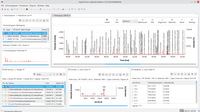
Photo from wikipedia
Abstract Fuels produced from microalgae are a promising alternative for fuels from fossil resources. Algae biomass may be transformed by hydrothermal liquefaction (HTL) into biocrudes, which need upgrading by hydrotreatment… Click to show full abstract
Abstract Fuels produced from microalgae are a promising alternative for fuels from fossil resources. Algae biomass may be transformed by hydrothermal liquefaction (HTL) into biocrudes, which need upgrading by hydrotreatment to meet transportation fuel requirements. In this study, analyses of HTL biocrude catalytically hydrogenated in a batch reactor at temperatures between 360 and 400 °C and residence times between 2.5 and 10.2 h are presented. Selected samples were investigated by comprehensive gas chromatography mass spectrometry (GC×GC) using flame ionization (FID) or mass spectrometry (MS). The main components of the samples before and after the hydrogenation are hydrocarbons of different unsaturation including alkanes, alkenes, monocyclic and bicyclic hydrocarbons and monocyclic aromatic hydrocarbons. Also, small amounts of polyaromatic hydrocarbons are formed. The most frequent class of heteroatomic compounds are nitrogen and oxygen containing compounds. Oxygen containing compounds are primarily of phenolic nature, whilst nitrogen containing compounds show aromatic amine (alkylated aniline and isomers) and pyrrolic structures (alkylated indoles and carbazoles and isomers). Upon proceeding hydrogenation, an increasing content of lower molecular weight hydrocarbons is observed. The analyses allow to track the decrease of heteroatomic compounds and reveal the structure of refractory compounds. Ultimately, the results allow to identify optimum parameters for the hydrogenation of HTL biocrudes from algae, which correspond to a maximum yield of hydrocarbons and acceptable levels of heteroatomic compounds.
Journal Title: Fuel
Year Published: 2019
Link to full text (if available)
Share on Social Media: Sign Up to like & get
recommendations!